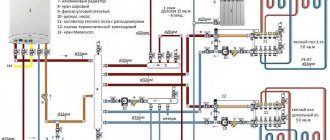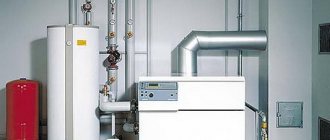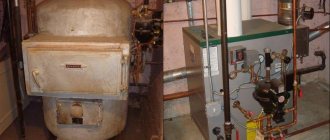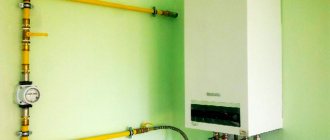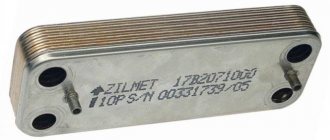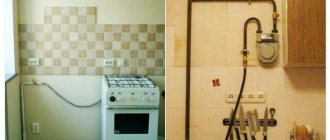Purpose and description of the main components of the AOGV - 17.3-3.
The appearance of the heating gas boiler AOGV - 17.3-3 is shown in Fig. 1 , and its main parameters are given in the table.
| Dimensions (H×W×D), mm | 1050×420×480 |
| Weight, kg | 49 |
| Rated thermal power, kW | 17,4 |
| Heated area, m2 (no more) | 140 |
| Type of fuel | natural / liquefied gas |
| Fuel consumption, m3/h, (kg/h) | 1,87 (1,3) |
| Hot water consumption at 35°C | 5,4 |
| Chimney diameter, mm | 135 |
| Nominal gas pressure, Pa | 1274 |
| Minimum gas pressure, Pa | 635 |
| Removal of combustion products | natural craving |
| Burner type | atmospheric |
| Heat exchanger material | steel |
| Type of installation | floor |
| Automation type | electrically independent |
Signs of a gas boiler automation malfunction
Installing automation on a heating boiler protects equipment from breakdowns. The device regulates the operation of the equipment. In the absence of traction, a drop in electricity, water or gas, the equipment gives a signal, turning off the device. The converter also saves resources - when the heating is sufficient, it stops the device, and when the water drops by 10 - 15 degrees, it updates the process. But even such a useful part sometimes requires repair.
Clients often contact the service center with the following problems:
- Extraneous noise in the case.
- The burner does not light.
- Doesn't heat up, won't turn on.
The cause of an emergency situation may be a breakdown of the automation. Since the design regulates the entire operation of the boiler, its malfunctions lead to shutdown of the device. In this case, calling a specialist is necessary.
Boiler automation repairs are carried out in several stages:
- Diagnosis of failure.
- Cleaning parts and components.
- Replacement of spare parts.
- Assembly.
Having arrived on call, the specialist conducts an external inspection of the device. Researching the equipment allows the technician to determine the cause of the problem.
Engineering communications service Heating, water supply, drainage, sewerage systems
around the clock tel: 8
INSTALLATION, REPAIR, MAINTENANCE, MODERNIZATION, REPLACEMENT
Having identified the problem, the gas expert begins troubleshooting. To do this, the equipment is cleaned, because clogging of pipes, burners, and filters leads to incorrect operation of the device, which causes it to shut down.
After cleaning the units, contacts and parts, the technician replaces the broken parts. This could be replacing a traction sensor, a temperature sensor, torn valves, or a burnt-out bimetallic plate, which plays the role of a sensitive element. After replacing the parts, the specialist installs the automation on the boiler.
Heating the cottage
House heating
Home water supply
Dacha water supply
Causes
Let's consider the reasons from the most trivial to serious breakdowns:
- There is no gas supply in the system: the valve on the pipe is closed or there is no gas directly in the room.
- The boiler is not plugged in: there is no spark, the flame cannot be lit, although there is a slight smell of gas.
- The hood is closed: the boiler gives a spark, there is ignition, but the flame goes out very quickly.
- The fuses on the electronic board have burned out: this often happens during sudden power surges in the network.
- Problems with the ionization electrode: it either moved away from the board or burned out completely.
It’s not difficult to determine “by eye” why a gas boiler won’t ignite, so before you hang up the service calls, first check yourself: have you done everything to light the boiler?
Operational repair of gas boiler automation
The service is in a hurry to help its clients. With our technicians, equipment repairs will be carried out comfortably and quickly. A large staff of specialists allows us to send a technician who has experience in repairing a geyser of your particular model. And these are not all the advantages of cooperation with us.
By contacting us, clients receive:
- Prompt processing of applications.
- Quality guarantee.
- Adequate cost of the service.
Our website is open seven days a week. Do you need to urgently repair your gas equipment? We will find a master who will come to your home even on a day off!
We monitor the work of our employees so that clients are always satisfied with the result. We issue a warranty card for the services provided.
Heat loss calculator
Calculator for the number of radiator sections
Heated floor calculator
The cost of repairing heating equipment depends on the complexity of the breakdown and the boiler model. The manager will tell you the full cost when clarifying the details of the breakdown, but it will definitely pleasantly surprise you.
If you have any questions, call or leave a request on the website. We will promptly send a technician to repair any equipment breakdowns, please contact us!
How to solve?
If the pump is working properly, but there is no heat in the house due to significant gas consumption, then you need to clean the heat exchanger. The procedure is performed only by specialists who use special liquids of high acidity.
Incorrect errors on the screen
The boiler went out for some reason, and a code appeared on the display. Naturally, the first thought is to look at the instruction manual, but what to do if such a code is not there?
Cost of installing boiler equipment
Installation
| Solid fuel boiler (15% of the boiler cost) no less | PC | from 10 000 ₽ |
| Floor-standing gas/diesel boiler (15% of the cost of the boiler) no less | PC | from 10 000 ₽ |
| Pellet boiler (10% of the cost of the boiler) no less | PC | from 15,000 ₽ |
| Wall-mounted single-circuit boiler up to 30 kW | PC | from 9 000 ₽ |
| Wall-mounted 2-circuit boiler up to 30 kW | PC | from 10 000 ₽ |
| Pump (D, up to DN 32) | PC | from 3 150 ₽ |
| Pump group (pump, shut-off valve assembly) | PC | from 2 500 ₽ |
| Expansion tank for heating system (up to 100 l.) | PC | from 2 500 ₽ |
| 3-way valve (D, up to 1 1/4″) | PC | from 2500 ₽ |
| 3-way valve mixer servo drive (D, up to 1 1/4″) | PC | from 3 150 ₽ |
| Chimney (D, up to 250 mm.) | m/linear | from 2,500 ₽ |
| Boiler (water heater, up to 200 l.) | PC | from 8 500 ₽ |
| Boiler (water heater, up to 500 l.) | PC | from 10,000 ₽ |
| Boiler safety groups | PC | from 2 250 ₽ |
| Water Heater Safety Groups | PC | from 2 250 ₽ |
| Boiler manifold | PC | from 5,500 ₽ |
| Hydraulic separator | PC | from 2,500 ₽ |
| Heated floor temperature control groups (thermostatic valve, thermostat with clamp-on sensor, bypass valve, starter) | PC | 3 750 ₽ |
| Fuel tank connection | PC | 5 000 ₽ |
| Fuel filter installation | PC | 2 000 ₽ |
| Air vent, thermometer, pressure gauge per unit | PC | 650 ₽ |
| Ball valve, mud filter, check valve | PC | 500 ₽ |
| Check the cost by phone: | 84957446774 |
Attention. This cost is a preliminary estimate; these prices should only be used as approximate prices. The exact cost of the work is calculated after an engineer visits the work site, its complexity, and quantity.
Commissioning works
| Commissioning of a wall-mounted gas boiler | PC | from 10 000 ₽ |
| Commissioning of boiler house up to 60 kW (protherm, ferroli, baxi, dakon) | PC | from 14,000 ₽ |
| Commissioning of boiler house up to 60 kW (Vaillant, Viessmann, Buderus) | PC | from 18,000 ₽ |
| Commissioning of boiler house from 70 to 120 kW (protherm, ferroli, baxi, dakon) | PC | from 20,000 ₽ |
| Commissioning of a boiler house from 70 to 170 kW (Vaillant, Viessmann, Buderus) | PC | from 25,000 ₽ |
| Commissioning of a cascade boiler house (2 boilers or more) | PC | from 30,000 ₽ |
| Commissioning of electric boiler up to 6 kW | PC | from 7 000 ₽ |
| Commissioning of electric boilers from 8 to 30 kW | PC | from 8 500 ₽ |
| Commissioning of a pellet boiler up to 50 kW | PC | from 14 000 ₽ |
| Commissioning of pellet boiler from 60 kW to 100 kW | PC | from 18,000 ₽ |
| Commissioning of a boiler room with a pellet boiler up to 60 kW | PC | from 20,000 ₽ |
| Check the cost by phone: 8 495 744 67 74 | _____________ | |
| The exact cost is calculated after receiving the technical | _tasks_ |
Attention. This cost is a preliminary estimate; these prices should only be used as approximate prices. The exact cost of the work is calculated after an engineer visits the work site, its complexity, and quantity.
Causes
The key reason is scale on the heat exchanger tubes, which significantly narrows their clearance. As a result, at the same gas flow rate, the heat transfer process is significantly reduced.
Expert opinion
Grebnev Vadim Savelievich
Heating system installer
Do not use tap water to fill the heating system. When it heats up, scale forms, which will have to be cleaned periodically. Softened water, which can be purchased in specialized stores, is better suited for these purposes.
Boiler room maintenance cost
Technical (service) maintenance of the boiler room
| Name of works | Volume | Price |
| Service contract for floor-standing boiler (gas, diesel) up to 60 kW | with 1st scheduled departure | from 14 000 ₽ |
| Service contract for floor-standing boiler (gas, diesel) from 60 to 170 kW | with 1st scheduled departure | from 20 000 ₽ |
| Service contract for floor-standing boiler (gas, diesel) up to 60 kW | with 2 scheduled trips | from 22 000 ₽ |
| Service contract for floor-standing boiler (gas, diesel) from 60 to 170 kW | with 2 scheduled trips | from 30 000 ₽ |
| Service contract for wall-mounted gas boiler | with 1st scheduled departure | from 10 000 ₽ |
| Service contract for wall-mounted gas boiler | with 2 scheduled trips | from 15 000 ₽ |
| The exact cost is calculated after check-out | engineer |
Attention. This cost is a preliminary estimate; these prices should only be used as approximate prices. The exact cost of the work is calculated after an engineer visits the work site, its complexity, and quantity.
Boiler room repair, diagnostics and prevention
| Name of works | Volume | Price |
| On-site inspection and diagnostics (without repair) | up to 50 km from MKAD | from 3,500 ₽ |
| On-site inspection and diagnostics (without repair) | from 50 to 100 km from MKAD | from 5,500 ₽ |
| Cleaning the burner (atmospheric) | power up to 60 kW | from 2,000 ₽ |
| Cleaning the burner (supercharged) | power up to 60 kW | from 3,500 ₽ |
| Cleaning the burner (atmospheric) | power from 60 to 170 kW | from 8,500 ₽ |
| Cleaning the boiler combustion chamber | power up to 60 kW | from 4,000 ₽ |
| Cleaning the boiler combustion chamber | power from 60 to 170 kW | from 6,000 ₽ |
| Checking and pumping up pressure in the expansion tank | without dismantling work | from 2,500 ₽ |
| Checking and pumping up pressure on the expansion tank | with dismantling and installation | from 4 500 ₽ |
| Refilling the heating system with a pump | system volume up to 200 liters | from 3 000 ₽ |
| Replacement of heating element, pump, heat exchanger, with coolant drain | for a unit | from 3 000 ₽ |
| Conversion of a gas boiler to liquefied gas | for a unit | from 3 000 ₽ |
| Burner settings | gas / diesel | from 2 500 ₽ |
| The exact cost is calculated after check-out | engineer |
Attention. This cost is a preliminary estimate; these prices should only be used as approximate prices. The exact cost of the work is calculated after an engineer visits the work site, its complexity, and quantity.
Briefly about the main thing
In order to know what needs to be done when the pressure drops and the gas boiler turns off, you need to have an idea of what malfunctions can lead to such a development of events. As a rule, the consumer of gas heating equipment faces the following series of problems:
- Fault with error code displayed.
- No indication.
- No ignition.
- The boiler does not operate in any mode.
In this case, the reasons can be both external and internal. The first includes insufficient fuel pressure, violation of smoke removal, violation of operating conditions, the second includes breakdown of electronics and individual components. Most often, the boiler turns off due to lack of ignition, a drop in coolant pressure and electronic failure. In each case, professional diagnostics are required to restore the unit’s operation.
Ratings 0
Connection nuances and verification
Connect the thermoelectric converter to the measuring device using a compensation cable. In order to minimize the measurement error as much as possible, the cores of this wire are made of the same material as the sensor itself.
Check the functionality of the thermocouple as follows:
- one end of the device is connected to a multimeter;
- the other end is manually heated using a lighter or gas torch.
To check the functionality of the thermocouple, connect one end of the device to a multimeter.
If the device is in good condition, this is indicated by the presence of a voltage in the region of 50 mV.
An effective way to descale
To carry out the highest quality cleaning of equipment, you can use a modern device - a booster. It will effectively solve the problem of how to flush a gas boiler from limescale.
What does the booster include:
- circulation pump;
- container for loading reagents;
- electric heating part.
The booster functions as follows:
- the reagent is heated in a special container (in order to increase its cleaning properties);
- the circulation pump pumps the heated reagent into the coil;
- chemicals circulate through the heat exchanger and clean the walls;
- the spent reagent with dirt pours out.
The heat exchanger must be cleaned regularly, at least once a year. However, this procedure can be repeated more often if the quality of the coolant is very low. If ordinary tap water is poured into the system, then it is very simple to determine this: observe how quickly scale forms on the kettle. Hard water “suffers” from this deficiency.
Preventive recommendations
It’s not for nothing that they say: the best repair is prevention. Gas boilers require annual preventative maintenance, which must be carried out before the start of the heating season.
If possible, maintenance should be carried out twice a year: before the start of the heating season and after it ends.
Check all previously discussed boiler elements to ensure they are in good working order. Follow the prevention recommendations given by the manufacturer in the instructions specific to your boiler. Correct any problems that arise in a timely manner, if possible.
Remember! A gas boiler is a potentially dangerous piece of equipment. If it is used incorrectly and problems are not corrected in a timely manner, irreparable consequences may occur. Therefore, be careful and do not carry out any repair work if you doubt your abilities and the correctness of your actions. Otherwise, follow the instructions received.
Other models
In practice, cleaning burners follows the same principles. The differences lie in their removal and reassembly.
The following examples are provided:
For example, the Helios AOGV 4 parapet apparatus is equipped with Eurosvit 360 automation and burners of the European brands Bray and Polidoro.
The burner set is removed following the example of the Zhitomir process. A pump is used to clean the nozzle, and hard brushes are used to clean the surfaces.
The Conord line stands out in particular.
The automation variations here are:
- AGU-T-M (Russia),
- "Eurosvit" (Italy),
- Honeywell (USA).
The most popular is the second variation:
It includes a sectional burner, Polidoro tubes, igniter, thermocouple, gas valve, temperature indicator and wires.
A similar system is available in the Lemax Premium 12.5 model.
Only the burner here is micro-flare. The mechanism is very easily removed by removing the top cover and lightly unscrewing the fixing bolts.
Its analogues are also found in the Siberia models.
Ecological burners "Vorgas" are used here.
Does not lag behind in this regard. Here its models Novella Maxima 108 N RAI and Mynute Boiler stand out.
Honeywell automation looks like this:
It has a similar operating principle to the Eurosvit system. The differences lie in the materials of some components.
It is often found in wall-mounted modifications, for example in Baksi Fortech 24
It also has an ecological burner that leaves no combustion products.
An equally popular device is the Ariston ALTEAS X 24 FF NG.
Many Daewoo models operate with similar automation. For example – DGB 200 MSC.
Whatever model or brand you have, strictly follow the suggested instructions for removing and reinstalling the burner block. Clean it thoroughly with the right products 1-2 times a year. Maintain other mechanisms as well. And then your boiler will work properly for a long period.
Air turbine
Bearings are the most problematic part of any fan. Due to the increase in the coefficient of friction in the bearing, heating increases and the rotation speed of the rotor, and therefore the blades, significantly decreases. There is another reason for the heating of the housing associated with a decrease in the performance of the air turbine - interturn short circuit.
In the first case, you can carry out the repair yourself by unscrewing the device and lubricating the bearing with “graphite” or any other high-temperature-resistant lubricant. In case of problems with the motor winding, it is unlikely that it will be possible to solve this issue without the intervention of specialists.
Causes
Loud operation of the equipment is caused by the following possible reasons:
- There is a shortage of water in the heating system, the presence of airiness - you should definitely check the pressure gauge readings, and also bleed the air from each battery.
- The formation of scale in the coolant, which breaks off with temperature changes and contributes to overheating of the antifreeze.
If the boiler becomes noisy, do not ignore it, but immediately call a specialist to find and fix the problem.
Settings failed
Settings are a “trouble” that can affect the owners of almost all energy-dependent boiler systems, regardless of the manufacturer and brand of equipment. The problem may be a voltage drop that caused the settings to fail. But, more often than not, the boiler begins to work inadequately after the intervention of the owner or “would-be repairmen” from the nearest workshop.
Advice: Repairing the control board of a gas boiler yourself is a thankless task: any problem related to electronics can lead to failure of the boiler installation or, worse, to an emergency. Entrust the competent adjustment of the boiler to professionals.
The gas burner is one of the key elements of the boiler unit. Its choice determines the functioning of the boiler unit, its cost and efficiency. There is a wide variety of burners on the market now. To choose the right option, you need to understand how they work and how they differ from one another.
Device and purpose
Gas burners installed in boilers are devices in which gas and oxygen necessary for combustion are mixed. The composition is directed to the output nozzles, and there it is ignited by a spark or a piezoelectric element. This creates a stable, directional flame.
The further main task is to maintain stable combustion of the mixture. In addition, modern models have integrated automation elements that, when an emergency occurs, turn off the burner, which increases the safety of the boiler.
The design often contains special functional parts that make it possible to carry out work in a safe mode and automate it. For example, thanks to the built-in automation, in the event of a malfunction, the device can turn itself off.
Structurally, a gas burner is a relatively simple device, and its use does not pose any significant difficulties. It includes a housing, an injector, a fuel regulator, an ignition mechanism, automatic elements, and a flame sensor.
Requirements for burners
- Uninterrupted provision of the required temperature conditions to warm the coolant to the desired state;
- Safe and reliable operation. The device must function stably and prevent the torch from coming off when the load changes within the normal range;
- Complete combustion of the oxygen-gas mixture;
- The least possible emission of harmful combustion products during operation of the device;
- Low noise level. This requirement is especially important for domestic use, when the boiler is located in a residential area or adjacent to it;
- Long service life;
- Availability of an automatic system. In case of flame interruptions, the automation must block the fuel supply;
- Economical in operation - heat losses should be
Classification of burners by air supply method
There are three types of this equipment, which differ in the method of obtaining the oxygen-gas mixture:
- Atmospheric. The main element in them is the ejector through which gas passes. A low pressure zone is formed in it, where outside air is sucked in. The main advantages of these devices are simplicity of design, small overall dimensions, low noise operation, low prices, the ability to install and convert a solid fuel boiler to this burner. Disadvantages - low efficiency (89-93%, so atmospheric burners are usually used in everyday life for heating small rooms) and air rarefaction;
- Fan (blown) Their operating principle and design are more complex. Installed in boilers with a closed combustion chamber. In this case, the air is not pumped due to a pressure difference, but forcibly - using a built-in fan. Therefore, it becomes possible to regulate the flow power of the oxygen-gas mixture. Other advantages are the absence of power restrictions, increased safety due to the presence of a closed combustion chamber (this prevents combustion products from entering the premises due to reverse draft), a high level of automation, and lack of sensitivity to pressure changes. There are also disadvantages: noisy operation, relatively high price, connection to the power supply is required due to the presence of a fan in the system.
- Diffuser-kinetic. According to the principle of air supply, they are a cross between atmospheric and fan. Air is supplied to the combustion chamber in certain portions through special diffusers as the fuel burns. This thoughtful approach achieves the highest possible efficiency. The disadvantage is the high price.
Classification by type of adjustment
According to regulation, the following types of gas burners are distinguished:
- Single stage. The principle of their operation is to automatically close the gas valve after heating the coolant to a set temperature. In this case, the burner temporarily stops functioning. After the coolant cools to the lower level, the gas valve opens again and the device resumes operation. Such burners are autonomous and do not require power supply. They are reliable, but in this mode they consume a lot of fuel.
- Two-stage. There are two operating modes. Initially, the burner operates at 30 or 40% power (depending on the model). After reaching a certain temperature state of the coolant and opening the gas valve, a transition to full (100%) heat supply occurs. The movement of gas fuel is precisely controlled. Advantages - continuous combustion, full heating of the coolant to maximum temperature. But this requires sophisticated automation, which can increase the cost of using the system, while still providing the necessary control; Two-stage continuously controlled gas burners also have two main operating modes. But their transition from one operating mode to another occurs much more smoothly than in the previous version, without sudden switches.
Accordingly, economical gas consumption, versatility in relation to the type of boiler, and the ability to regulate the coolant temperature relative to design values are ensured. In this case, a connection to the power supply system is required.
- Modulating burners. For atmospheric boilers, they can vary in thermal power. This is the most economical option. According to the modulation method, they are divided into mechanical, pneumatic and electrical. Electrical modulation allows for more precise control of key parameters. Such burners are considered the most advanced in terms of automation, they are universal, and thermal power is greatly saved due to the duration of operation.
Operation of universal boilers with gas burners
Solid fuel boilers of the current generation are also capable of working with fan-type gas burners.
They mix natural gas and oxygen-enriched air. After this, this mixture in the nozzle is ignited and a torch flame flares up.
There are boilers on the market with the possibility of combined use of natural gas and diesel fuel, since the physics of combustion of these substances is very similar. But gas heats the coolant more efficiently, and solid, and especially liquid fuel, promotes the horizontal distribution of thermal energy. Therefore, the walls of the boiler heat up more. Over time, this can lead to premature equipment failure due to insufficient coolant heating performance.
Therefore, given the existing possibility of installing gas burners in boilers with a different type of fuel, it is better to operate them in gas units.
Working with AOGV
It begins when the gas supply is blocked - the corresponding valve closes. And this is a general principle for similar work with any boilers and columns.
How to clean the burner of an AOGV gas boiler? After shutting off the gas, this element is removed from its position. The burner has a nozzle
It is carefully unscrewed and carefully cleaned with a brush. The burner itself is cleaned by blowing using a special pump
Then the nozzle and burner are returned to their place.
These are general criteria. And the details are presented on the next two models.
First. AOGV 11.6-3. This is a reliable and practical device.
But after a certain period of operation, it is thoroughly cleaned. The process goes like this:
The burner block is removed
To do this, the pan of the apparatus is rotated, and three tubes are disconnected from the automation unit: contact, gas and thermocouples. Carefully unscrew the nuts located on the fittings of the automation mechanism. The paronite gasket on the main gas pipe is removed and its conditions are studied. If it is damaged, it needs to be replaced. The marked pallet is taken out through the groove, which is as close as possible to the tubes
The casing is also pulled out along with it. When fixing the lower part of the tray, point it towards you and remove the remaining holders (two pieces) from the engagement. This entire assembly falls to the floor. The main burner is examined and cleaned. The igniter nozzle is inspected. The wick and thermocouple are unscrewed. The box-shaped casing is separated from the pilot burner. This clears the way to the nozzle. If it is brass and there is plaque on it, it can be removed with fine-grained sandpaper. Cleaning the nozzle. To do this, thin copper wire and a blowing method under high pressure are used. The second action is carried out by a special pump on the side where the tube is connected to the tee. The same sandpaper is used to very carefully clean the bend of the thermocouple tube.
After this work, all the parts are assembled using the reverse algorithm. Smoothly, avoiding distortions, lift the entire block. The burner should be inside the housing, and the igniter and thermocouple should not touch the casing flange.
From the side of the tubes, the entire assembly should be tilted towards itself with a slight downward slope. The opposite side of the tray should rise.
Then feed it forward and simultaneously put on a pair of distant holds. They should be on the casing flange. The nearest hook goes to a cut groove. After it enters there, the entire pallet rotates in the opposite direction to the clockwise direction. The gas pipe should be positioned only under its branch pipe of the automation unit.
Next, it is tested how correctly the gaskets fit, and all the tubes are returned to their places. The wrench tightens the nuts on two tubes: the igniter and the gas tube.
Before reassembling the thermocouple tube, its contact areas are carefully but carefully cleaned. The nut here is tightened with your fingers.
The final stage is to check the tightness of all connections for potential leaks. If they are absent, the boiler turns on. If available, these places are covered with sealant, the nuts are tightened.
The second model is AOGV-23.2-1 Zhukovsky.
It works like this:
- The nut is unscrewed so that the gas pipe passes through.
- The angle, igniter and thermocouple are unscrewed.
- All burners in the set stretch outward and extend to the side towards the user. If there are difficulties with their movement, loosen and unscrew the studs with pliers. Clean all jets and other components.
- Disassembly of burners. To do this, unscrew 4 pins on both sides.
- The plates with slots are removed from the top of the burners, then the springs. All parts are thoroughly cleaned.
- Reassemble all elements in reverse order.
After reassembly, a leak test is carried out to examine how tightly the burners adhere to the body.
The situation with Zhytomyr
This brand is famous for its devices with piezo ignition. For an example of burner cleaning, the Zhytomyr 3 model, equipped with EURO SIT technology, is used.
The following list of tools is required for the operation:
- Screwdriver. A flat tip is required.
- Open-end wrenches.
- A regular brush and its analogues for cleaning metal products.
- Yorshik.
After blocking the gas with a key, remove the screw securing the boiler door. It is removed entirely. This way the core of the unit becomes open.
The main burner is concentrated in its lower zone. To remove it and subsequently clean it, you need:
- Disconnect the cable from which the piezoelectric element and electric ignition operate.
- Use a key to remove the thermocouple and its clamp from the valve.
- Mark with a marker the distance of immersion of the nozzle into the burner itself. This will make it easier to return it to the correct position.
- Unscrew the nut securing the valve to the burner. Communication goes through a copper tube.
- Carry out the same manipulations with the ignition electrode.
- Using a screwdriver, remove the two fixing nuts of the other burner (pilot). There is a gasket underneath. If it is damaged or deformed, replace it.
- Remove the nozzle from the burner. If the process is difficult, gently tap around this part with a key.
To dismantle the main burner, the screw connecting it to the boiler body is released. Then it is removed. To do this, you need to grab its lower part and the copper tube and sharply pull it out of the valve.
The screw that fixes the insertion distance of the nozzle part is loosened.
For the cleaning itself, a brush and a brush are used. Carbon deposits are carefully removed.
A vacuum cleaner is used to clean the holes. All work affects both external and internal components.
This algorithm is also suitable for the procedure with the burner of the Dani AOGV series devices, for example -11.5; 23.2 and 29.
You can do the same with many similar units: Aton AOGV 16-EM, ZhMZ-AOGV 17, etc.
The injectors also need to be cleaned. Carbon deposits from the top side are removed with a brush. A wire or thin needle is used to clean the holes.
After this, all the parts are assembled using the reverse algorithm.
